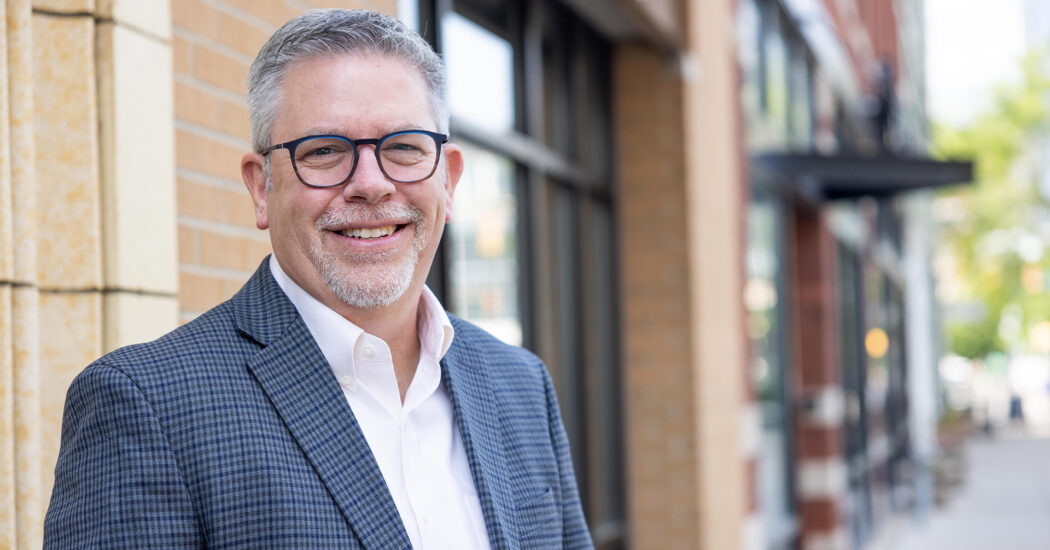Nick Holmes Q&A: Building Connections Through Design
-
Category
Careers + Culture, Leadership -
Posted By
Schmidt Associates -
Posted On
Jan 03, 2025
From designing green roofs in California to building homes in Kentucky, Nick Holmes’s architectural journey is rooted inadaptability, hands-on experience, and a passion for client-centered design. Now a client liaison for K-12 projects, Nick shares how his diverse background fosters connections and transformational design.
In this Q&A, Nick reflects on his career, the projects that have defined him, and his commitment to accessibility, inclusivity, and servant leadership at Schmidt Associates.
Professional Journey and Client Engagement
Tell us about your professional journey—what led you from architecture to client engagement? How has this shaped your perspective on the design process?
After starting my career designing green roofs in California, I returned to my Kentucky roots during the recession and gained invaluable hands-on experience as a carpenter and business owner. Within a year, I launched my own residential design/build business and later embraced roles as an architectural designer, project manager, creative team manager, and now client liaison for education projects in Kentucky.
These diverse roles shaped my perspective and now fuel my passion for client engagement in K-12 projects. As a client liaison, I leverage this broad experience to understand clients’ needs and collaborate with educational leaders to bring their visions to life—a role I truly love and feel uniquely suited for.
Which projects have been the most meaningful to you, and what made them stand out?
One project I’m particularly proud of is the new entry to the Frazier Museum on W. Main Street in downtown Louisville. The design features a modern steel-and-glass cube and a linear park that stands out as distinctly contemporary while harmonizing with its historic surroundings.
What made this project special was the client’s clear and ambitious vision, which brought together a talented team to bring it to life. As the project transitioned from design to construction, my role evolved from lead designer to on-site project manager, ensuring the design’s quality translated seamlessly into the final product. Being located in my home city, this project holds personal significance and marks a period of rapid professional growth for me.
How does your architectural background enhance your ability to serve Schmidt Associates’ clients?
My architectural background equips me to “speak many languages” and view projects through diverse lenses to achieve the best outcomes. I understand the unique concerns of owners, facility managers, designers, and contractors, and I prioritize listening and learning from each perspective. This holistic approach ensures that every voice is heard, fostering collaboration and delivering solutions that align with everyone’s goals.
Listening is a core part of being a client liaison. How do you ensure clients feel truly heard throughout the process?
It may seem simple, but eye contact, attentive body language, and affirming gestures like head nods go a long way in making clients feel valued. During natural pauses in the conversation, I ask clarifying questions to deepen understanding. I also document all key points discussed in meetings and follow up with an email to ensure everyone is aligned and the important details are accurately captured.
While these techniques can be learned quickly, it’s genuine empathy and broad experience that help guide the most meaningful and insightful clarifying questions, ultimately fostering stronger connections and trust with clients.
What drew you to Schmidt Associates, and how does servant leadership shape the company’s leadership style?
The emphasis on servant leadership was one of the key factors that drew me to Schmidt Associates. Our CEO’s journey—rising through the ranks and becoming an expert in designing educational spaces—sets a powerful example for the entire company. It ensures leadership decisions are informed by firsthand experience and a deep connection to the work.
How does Schmidt Associates incorporate servant leadership into its approach with clients?
Servant leadership also means setting aside ego for the benefit of the client, the project, and the end user. This philosophy fosters better design outcomes and stronger, long-term relationships. It’s a principle that has been integral to Schmidt Associates’ success for almost 40 years.
What is one of the most important lessons you have learned throughout your career so far? How has this lesson shaped your leadership or approach to client relationships?
Architecture is a complex profession often driven by tight deadlines, and mistakes are inevitable. The key is not to hide them but to acknowledge, address, and let others learn from them. This principle applies equally to an intern and a CEO.
No one expects perfection, but honesty and accountability are non-negotiable. Embracing this lesson has shaped my approach to leadership and client relationships, fostering trust and collaboration through transparency and integrity.
Advocacy, Accessibility, and Inclusivity
As vice president of the board of directors for Down Syndrome of Louisville, how do you balance your advocacy work with your professional commitments? What tools or approaches have helped you maintain this balance?
I keep things simple when managing my commitments. I rely on calendar apps on my phone and, for particularly important tasks, I write them on a Post-it note and tuck it neatly in my wallet. I also make it a habit to visualize my day the night before, which helps me stay organized and prepared.
What truly makes this balance possible, though, is having an employer who values community involvement and a supportive, encouraging spouse. Their understanding allows me to fully engage in both my professional and advocacy roles.
How do your advocacy efforts, particularly with Down Syndrome of Louisville, align with Schmidt Associates’ commitment to inclusivity in design?
As a teenager, I worked as a camp counselor for children with disabilities, which helped me view differences as something to celebrate rather than fear—an outlook reinforced when my daughter Mabelle was born with Down syndrome. This perspective reminds me that we are all temporarily able-bodied and should design with both empathy for others and foresight for our own futures.
At Schmidt Associates, this perspective reinforces our commitment to inclusivity in design. If we fail to create educational environments that serve everyone, we’re neglecting a portion of students, which is simply unacceptable. Advocacy has taught me that inclusive design isn’t just a responsibility—it’s an imperative for achieving true equity, a principle that shapes every project we undertake.
From your perspective, why is accessibility and equity so critical for leaders in the AEC industry?
Every school superintendent and facility manager I’ve met values accessibility and strives to create equitable learning environments, even if budget constraints limit how far they can go. Their commitment to serving all students is clear, and as leaders in the AEC industry, we play a key role in shaping the built environment to support these goals.
We have both the responsibility to educate our peers on crafting accessible spaces and the duty to guide clients toward solutions that serve all populations. With the stroke of a pen, we have the power to shape a world that is either inviting and vibrant or stark and unwelcoming—it’s a responsibility we must take seriously.
Inspiration and Motivation
What inspires you most about working in the AEC industry? Are there any specific trends or challenges that excite you?
I’m inspired by the opportunity to shape spaces that inspire and nurture growth, especially when working with school leaders who prioritize long-term planning and sustainable strategies. These leaders understand the importance of creating buildings designed to endure for decades, fostering both immediate and lasting benefits. It’s exciting to see a shift where sustainability is viewed not just as a buzzword but as a core economic model, with clients embracing it as a long-term, cost-saving solution. This approach not only drives meaningful change but ensures that sustainable practices become integral to the way we design and build for the future.
What sets Schmidt Associates apart, and what makes working here unique for you? How do you see the firm’s values reflected in day-to-day projects?
What sets Schmidt Associates apart is the relentless pursuit of excellence and a deep commitment to servant leadership demonstrated by every team member. There’s a high standard here, coupled with a refreshing lack of ego—a combination that’s rare in this industry. Victories are celebrated as a team, and the work we do is always focused on the success of our clients and, most importantly, the end users.
Our projects might spend months or even years in our minds, on screens, and on paper, but it’s the end users—students, teachers, doctors, custodians, and more—who will spend decades living and working in these spaces. That perspective drives everything we do. Designing buildings that are uplifting, functional, and attuned to the needs of those who use them daily is central to our process, and it’s one of the many reasons I find working here so fulfilling.
Do you have any hobbies outside of work that excite or inspire you? How do your hobbies influence your creativity or problem-solving at work?
With three kids and two volunteer roles, I don’t always prioritize my own hobbies, but when I do find free time, I gravitate toward three activities: going to the YMCA, working in my garden, and making music.
Our YMCA membership is one of the best investments my family makes—it fosters our health and happiness. While it doesn’t directly influence my work, regular exercise keeps me more focused and productive, reminding me of the importance of balance.
Gardening, especially rescuing tree seedlings and planting them, is a joy passed down from my mother. I’ve nurtured and replanted many trees, even donating 100 to my kids’ school for Earth Day. This practice inspires resourcefulness and a long-term mindset—after all, the best time to plant a tree is 20 years ago; the second best is today.
Gardening inspires me to think long-term and nurture growth—a mindset that carries into my design work. Similarly, music has taught me the beauty of blending structure with creativity, a principle that mirrors architecture, often described as ‘frozen music.’
Nick’s journey illustrates how adaptability, hands-on experience, and a client-focused perspective can elevate the design process. His ability to navigate the technical and relational aspects of architecture ensures that bold visions are realized in meaningful, lasting ways. Through his diverse experiences and commitment to servant leadership, Nick exemplifies how thoughtful design thrives on empathy, collaboration, and a deep understanding of people and their needs.
At Schmidt Associates, team members like Nick are transforming educational spaces to inspire growth and foster learning. Want to see how Schmidt Associates transforms educational spaces? Explore our K-12 Studio and meet the team behind the designs.








